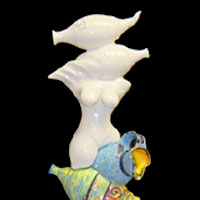I've read it in print and heard it expressed out loud, and now I too believe that one of the main reasons why I and so many other people are driven to make ceramics is because we have discovered that by shoving our hands into oozing, earthy, life-sustaining, soft, sticky, moldy, muddy clay that we can, for a brief period of time, reconnect with nature on a simple but intimate level. It is widely reported by many ceramists that when they begin working with clay that they feel rejuvenated and more in touch with the natural world. However, when I touch clay that tactile encounter takes me a step beyond the normal pleasant primal associations experienced by most potters. For me, contact with clay induces more than mere physical sensations—it also launches me into the realm of the imagination where my mind seems to give way to the world of the unconscious and its ancient archetypes. Not content to merely revel in the primal experience of tapping into my archaic inner-self, I often feel compelled to express these experiences directly in clay. This need to acknowledge the spiritual aspect of working with clay, through the medium clay, has motivated me to make work that celebrates and comments on my psychic association with the ceramic process itself. My association with the primal aspect of clay as terra firma, along with my desire to connect with the history, traditions, and the materials necessary for the production of ceramics, to include earth, fire, air and water, has led me to write my own kiln god myth, create kiln god/dess themed performance pieces, and finally to make kiln god/dess sculptures.
Inspired by myths and surviving primeval rituals about the craft and processes of pottery making and firing, my shrine-like sculptures, figurative deities and masks are modern interpretations of the potters' protective guardian of the kiln firing, the “kiln god.” While many different beliefs, customs and types of kiln gods have been produced since antiquity among diverse cultures throughout the world, it appears that kiln god customs in the United States are among the most unstructured in terms of not having any prescribed standards of form and appearance, or formally acknowledged rituals or customs. In the United States, kiln gods are more often than not, given the form of small fanciful figures or creatures that usually sport whimsical or grotesque features. Acting like charms or talismans meant to guard against all kinds of bad luck, kiln gods are designed to protect the ceramists' fragile ware from all types of harm, including unlucky aesthetic problems such as glaze defects, which sometimes occur during the precarious and final glaze firing. Furthermore, in the United States kiln gods, or kiln guardians as I sometimes like to refer to them, are usually spontaneously fashioned by potters from wet clay just prior to a kiln firing. Western kiln gods are most often displayed on the roof of a kiln just over the kiln door where they can “watch” over the firing, while the kiln gods of China are generally positioned in their own permanent Taoist or “folk religion” temple or shrine, that is always located near the kiln. In Chinese cities such as Jingdezhen and Hong Kong, kiln gods are still worshiped and honored as important deities that help to protect the welfare of the entire ceramic community. Each ceramic producing city or region of China has its own local deity.


